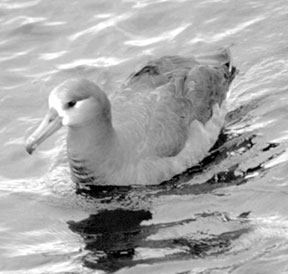Interview with David Hyrenbach—Spring 2006
This year we’ve had a few encounters with albatross, including a juvenile Short-tailed Albatross found near Bandon, OR (one of only about 1800 worldwide). What’s so special about albatross? Jane interviewed Dr. David Hyrenbach, a visiting scientist at the University of Washington from the Nicholas School of the Environment at Duke University, to find some answers:

David shows us what happens when you have bird on the brain. (DUML)
Why study albatross? Why not Canada Geese, or Western Gulls?
Anyone that sees an albatross for the first time can’t help but fall in love with these majestic birds. They’re also sensitive indicators of ocean health and human impacts—19 of the 21 albatross species are listed as threatened on the World Conservation Union (IUCN) red list.
Is there something we can do, as ordinary citizens, to help albatross?
Individual choices can have a big impact. Albatross are surface feeders—we’re starting to see albatross picking up all kinds of things—lighters, syringes, Styrofoam pellets. Obviously, we can’t stop buying plastics, but we can limit our consumption. Be smart; reduce, reuse and recycle; and make sure trash ends up in the proper receptacle.

A Black-footed Albatross taking a rest on the water. (E. Melvin)
What are some of the questions you’re interested in answering?
I’m interested to know how albatross use the ocean—how do they decide where to go? How do features like submarine mountains, ocean currents, and large scale climatic events influence foraging? At some point, adult albatross stop returning to the colony with food for the chick. For a while, the chick fasts, and then it begins its first voyage alone. How do they figure out where to go?
Albatross are wide ranging—how far do they go?
We satellite-tagged 18 Black-footed Albatross off the coast of California last year. Four birds (all males) traveled 7,000 km (over 4,000 miles) all the way to Japan. They’re capable of flying upwards of 60 km/hr (37 miles/hr).
I hear you’re pretty wide-ranging yourself—where has your research taken you?
I’ve worked near the Gulf of the Farallones (CA), the Outer Banks (NC), the Bering Sea (AK), and the Southern Indian Ocean.

Mindful of the sharp and powerful beak, a researcher holds a satellite-tagged Black-footed Albatross ready for release. (Oikonos)
So you’ve done research off both coasts... which is better, East or West Coast?
The West Coast, definitely. Am I allowed to go into politics at this point?
What are the biggest challenges to researching albatross (besides, of course trying to stay away from that hefty bill)?
Albatross don’t recognize boundaries—state, federal or international. To protect and understand these species, we need international collaboration.
How does COASST fit in?
COASST is essential for researchers investigating long term patterns and long term changes in the marine environment. We know so little about where seabirds go, especially during the non-breeding season. Comprehensive data on beached birds gives us a window into seabird—and specifically albatross—migration.